Deep learning reshapes industries. It will reach $40.3 billion in automotive. Innovators and businesses seize the chance to harness these frameworks.
TensorFlow offers vast versatility. Keras is user-friendly. These tools empower professionals and newcomers to unlock their data’s potential.
Embrace deep learning’s future. Master these tools. They will redefine technology.
Also read: 6 best free file recovery software
Understanding Deep Learning Software
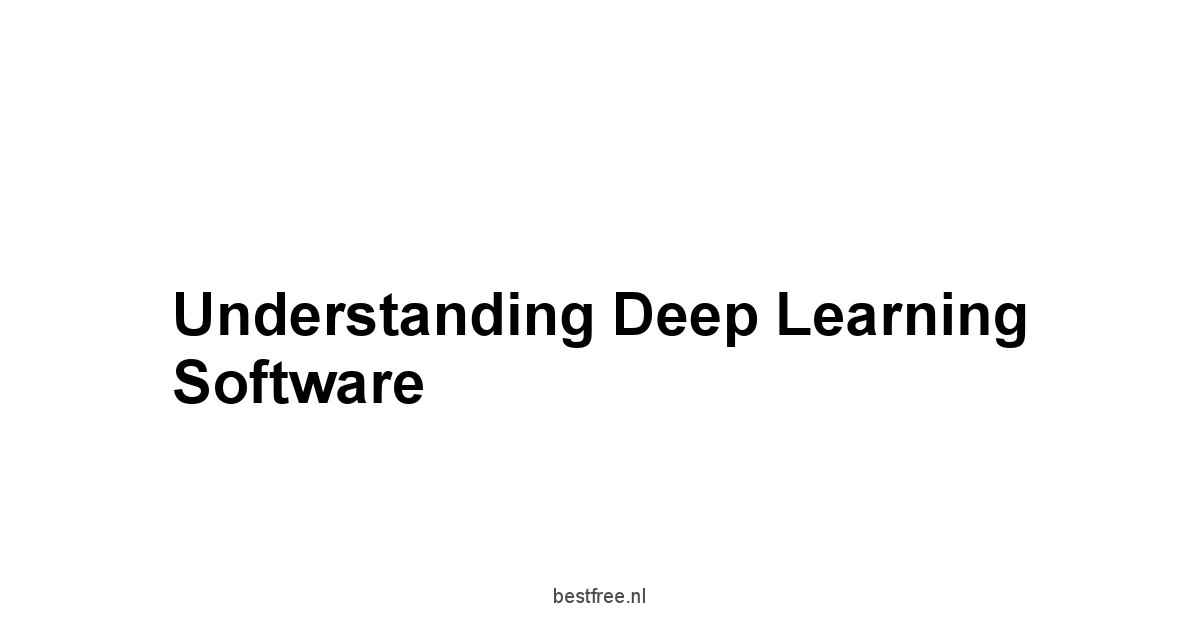
This field uses algorithms called neural networks, interconnected nodes that mimic how the human brain works.
These systems handle large data sets and uncover patterns that traditional programming overlooks.
Deep learning has changed industries like healthcare, finance, and transportation, improving predictions and automation.
The growth of deep learning software parallels the rise in computational power.
Today, businesses use deep learning software not just for data processing but for insights and predictions from past information.
This swift technological change demands strong, efficient, and adaptable tools for both beginners and seasoned experts.
What is Deep Learning?
Deep learning is a branch of machine learning, based on algorithms inspired by the human brain, called artificial neural networks.
Unlike traditional machine learning, where features are manually crafted, deep learning models learn from data in layers.
They extract features from raw data, identifying patterns and making decisions.
Key Attributes of Deep Learning:
- Layered Structures: Deep learning models consist of multiple layers that refine inputs. Each layer processes data in complex ways, making them suitable for image and speech recognition.
- Supervised and Unsupervised Learning: Deep learning algorithms handle both supervised tasks, with labeled data, and unsupervised learning, where they find patterns without labels.
- Scalability: Deep learning methods can adapt to any data size, crucial as data generation grows.
Deep learning applications range from medical diagnostics to social media recommendations.
Gartner’s research suggests deep learning will disrupt many industries, showcasing its potential.
Importance of Deep Learning in Modern Technology
Deep learning is vital in technology for processing vast unstructured data.
Its strength lies in learning complex functions directly from data, moving beyond the limits of manual feature extraction.
Significance in Various Sectors:
- Healthcare: Deep learning algorithms examine medical images for disease diagnosis, predicting outcomes, and personalizing treatments. Models can detect certain cancers in radiological images with over 90% accuracy.
- Finance: AI-driven analytics assist in fraud detection, risk management, and trading. The AI market in finance is projected to hit USD 11 billion by 2026.
- Automotive: Deep learning drives self-driving tech, identifying obstacles, predicting behavior, and enhancing safety. Investments in automotive AI research are expected to grow the market to USD 40.3 billion by 2026.
Deep learning’s significance transcends sectors; it fuels innovation across industries, reshaping capabilities and services.
Key Components of Deep Learning Software
Deep learning software are essential for developing, training, and deploying models.
They streamline model creation and enhance training efficiency in multi-layer networks.
Core Components of Deep Learning Software:
-
Neural Network Architecture: Frameworks offer various prebuilt models for customization, including convolutional layers for images and recurrent layers for sequential data.
-
Data Management Tools: Robust data handling tools are crucial, assisting in preprocessing and augmentation for optimized learning.
-
Optimization Algorithms: Key to training, these algorithms adjust weights to reduce errors. Popular methods include stochastic gradient descent and Adam.
-
Framework Features:
- Visualization Tools: Many frameworks include tools for tracking progress and debugging.
- Support for GPUs: The ability to use GPU acceleration is essential for performance.
- Community Support and Documentation: An active community and thorough documentation enable faster problem-solving and knowledge sharing.
These components together support effective deep learning systems, ready to address real-world challenges.
Their synergy drives innovation, allowing organizations to harness the full power of big data.
Also read: best free emergency notification software
Top Free Deep Learning Software in 2025
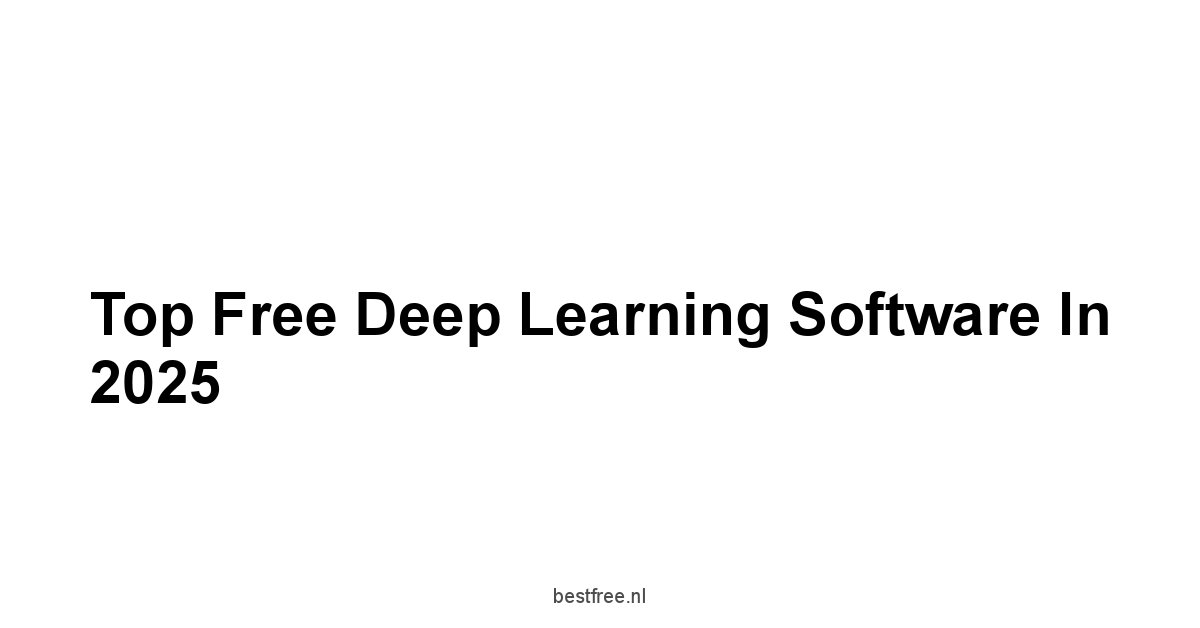
In 2025, several free deep learning tools stand out for their performance and community support.
TensorFlow: The Powerhouse
TensorFlow, made by Google, is one of the most used deep learning frameworks.
Its ecosystem helps users build and deploy machine learning models easily.
TensorFlow excels in computational power, supporting both CPU and GPU processing.
Features:
- Versatility: Creates various neural networks from feedforward to recurrent ones.
- TensorFlow Lite: Optimizes models for mobile and embedded systems.
- TensorFlow Serving: Deploys models in production.
With over 50,000 stars on GitHub, TensorFlow shows its popularity and support.
PyTorch: The Flexible Framework
PyTorch, a framework from Facebook, is known for its dynamic nature.
It allows real-time modifications, helpful for research and experimentation.
Key Features:
- Dynamic Computational Graph: Users can alter the graph during runtime, easing debugging.
- Rich Ecosystem: Supports various libraries, including TorchVision for vision tasks.
By 2025, PyTorch is favored for its ease of use and has more than 60,000 stars on GitHub.
Keras: Simplifying Model Creation
Keras is celebrated for its simplicity and user-friendly API, ideal for all skill levels.
It operates atop TensorFlow and Theano, making model setup quick.
- Rapid Prototyping: Quickly design and iterate on model architectures.
- Wide Support: Works with multiple backends, offering development flexibility.
In 2025, Keras remains a preferred high-level API, valued for its accessibility.
Apache MXNet: Scalability and Speed
Apache MXNet, an open-source framework, is noted for scalability and performance.
It supports many programming languages, enhancing developer accessibility.
Core Attributes:
- Efficient Memory Usage: Allows large-scale training on multi-GPU setups.
- Language Flexibility: Supports Python, R, Scala, and Julia.
MXNet’s 2025 adoption is highlighted by its partnership with Amazon Web Services for scalable machine learning.
H2O.ai: Accessible AI Solutions
H2O.ai offers an open-source platform for data scientists and machine learning developers.
It enables quick model building, even with little programming knowledge.
Highlights:
- User-Friendly Interface: Simplifies the modeling process with a graphical interface.
- Integrated Functions: Features for model evaluation and visualization.
H2O.ai has gained traction, especially among business analysts leveraging data.
Theano: Back to Basics
Theano is a pioneer in deep learning software, the foundation for many frameworks.
Despite newer options, it remains relevant for education.
- Symbolic Computation: Focuses on optimizing mathematical expressions.
- GPU Support: Enhances performance for GPU-based calculations.
In 2025, Theano’s educational value is still recognized, serving learners in machine learning.
Caffe: Fast Image Processing
Caffe, developed by Berkeley AI Research, is tailored for image processing.
Renowned for speed, it suits applications needing quick performance.
Key Characteristics:
- Model Zoo: Offers pre-trained models to speed development.
- Performance Optimization: Processes over 60 million images daily on high-performance hardware.
Caffe continues to be favored in the computer vision community.
CNTK: Microsoft’s Deep Learning Solution
The Microsoft Cognitive Toolkit, CNTK, shows Microsoft’s dedication to deep learning.
It trains models across multiple GPUs and supports dynamic computational graphs.
Advantages:
- High Scalability: Trains large neural networks efficiently.
- Flexible Programming: Supports C# and Python.
By 2025, CNTK is acknowledged for its enterprise potential in developing robust deep learning models.
OpenNN: Efficiency in Neural Networks
OpenNN is an open-source library focusing on performance in machine learning.
It suits industrial applications requiring high performance.
- Efficiency in Scaling: Manages large datasets effectively.
- Variety of Neural Networks: Supports feedforward and convolutional networks.
OpenNN attracts attention in engineering and finance for reliable predictive models.
DeeplearningKit: For Swift Users
DeeplearningKit is for developers using Swift.
It emphasizes GPU acceleration for effective computations.
- User-Friendly for Swift Developers: Simplifies deep learning using familiar structures.
- Support for Popular Architectures: Implements CNNs and LSTMs.
In 2025, DeeplearningKit bridges deep learning and Swift, aiding iOS developers.
Also read: best free video translation software in 2025
Features to Consider in Deep Learning Software
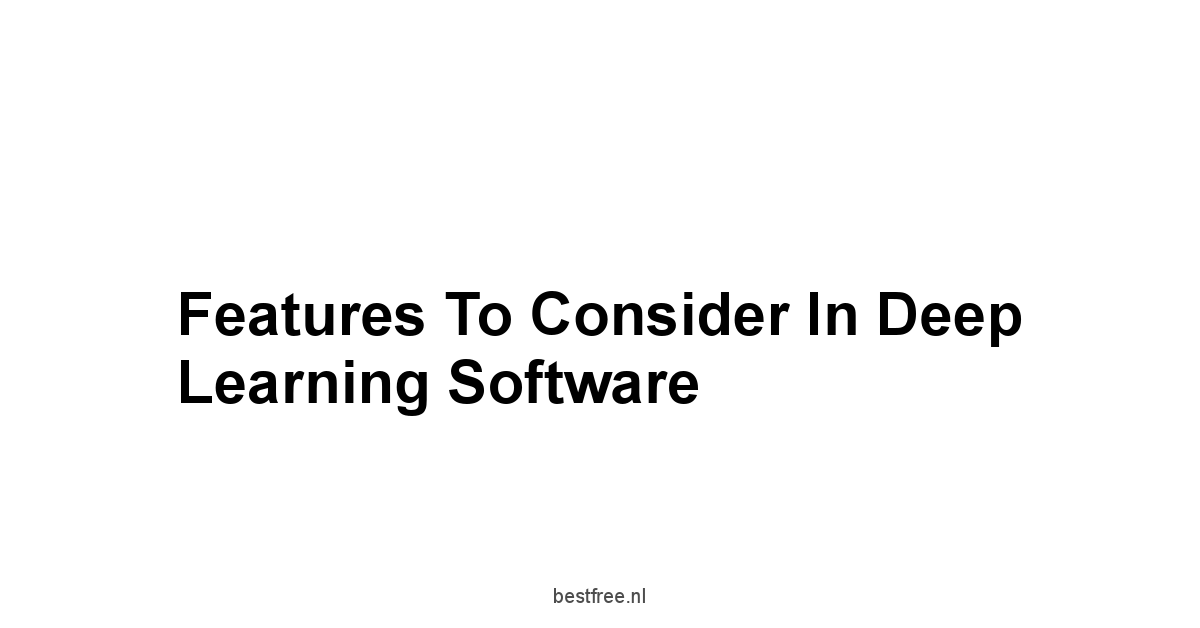
When selecting deep learning software, key features must be evaluated to maximize model development and training.
Consider performance, scalability, and usability tailored to the project needs.
Performance and Speed
Importance:
Efficient performance is essential for complex algorithms on large datasets.
The speed of training and inference affects productivity.
Factors to Consider:
- GPU Support: Many frameworks support GPU acceleration, reducing training time.
- Batch Processing: Processing data in batches enhances training performance.
A benchmark by MLPerf shows TensorFlow and PyTorch lead in performance for image classification tasks.
Scalability for Large Datasets
As data grows, software must scale effectively.
Scalable frameworks can handle larger datasets without losing performance or accuracy.
Characteristics:
- Distributed Training Options: Platforms like Apache MXNet and TensorFlow allow training on clusters for larger datasets.
- Adaptability: Adapting to varying input sizes is essential to avoid performance loss.
Scalability helps models evolve alongside growing datasets, preventing training problems.
Community Support and Resources
The community support for the software can impact the learning curve and development process.
An active community provides access to tutorials, troubleshooting, and examples.
Indicators of Strong Community Support:
- Documentation Quality: Clear, comprehensive documentation eases the onboarding for new users.
- Active Forums and Collaboration: Forums like GitHub and Stack Overflow foster collaboration and sharing.
TensorFlow and PyTorch have large communities that contribute resources, enhancing usability for developers.
Ease of Use and Learning Curve
Deep learning models can overwhelm newcomers.
Software with a gentle learning curve helps faster adoption.
Considerations for Usability:
- API Design: An intuitive API simplifies model construction and training.
- High-Level Abstractions: Tools like Keras provide essential functions to abstract lower-level complexities.
Choosing user-friendly software can speed up learning and provide significant insights.
Integration Capabilities
Integration with existing systems and multiple programming languages is vital for seamless workflows.
Key Features:
- Compatibility: Software should support a variety of tools and platforms for interoperability.
- Export and Import Functions: Easy export and import enhance collaboration across teams.
Integration features ensure deep learning software fits smoothly into existing technology, maximizing efficiency.
Also read: 7 best free html editors
Use Cases for Deep Learning Software
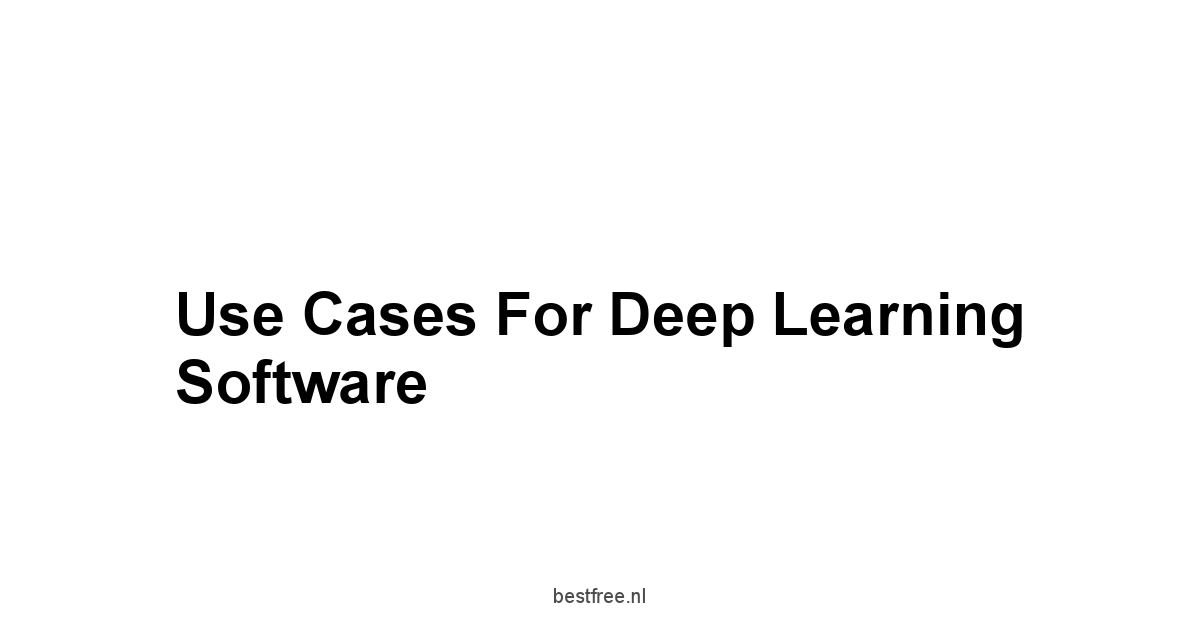
Deep learning software finds its place across many applications, using advanced computation to tackle unique challenges in various fields.
The impact of these technologies is profound, often changing how businesses operate.
Natural Language Processing
Deep learning has become essential for many natural language processing NLP tasks, including translation, sentiment analysis, and chatbot creation.
Deep learning models, especially recurrent neural networks RNNs and transformers, excel at understanding and generating language.
Examples of Applications:
- Chatbots and Virtual Assistants: Companies like Google and Amazon use NLP to improve user experience in their digital assistants.
- Sentiment Analysis: Businesses efficiently analyze reviews and social media to gauge customer sentiment.
A report by MarketsandMarkets projects the NLP market will grow from USD 8.61 billion in 2021 to USD 25.6 billion by 2026, showing the rising reliance on deep learning.
Computer Vision Applications
Deep learning sets a new standard in computer vision, advancing visual recognition and analysis.
Systems that use convolutional neural networks CNNs have changed fields like automotive safety and medical diagnostics.
Specific Use Cases:
- Facial Recognition Technology: Used in security systems, social media, and mobile devices for identity verification.
- Medical Imaging: Deep learning algorithms assist radiologists in identifying anomalies in X-rays and MRIs with greater accuracy.
The global computer vision market, valued at USD 11.94 billion in 2020, is estimated to reach USD 19.5 billion by 2026, mainly driven by deep learning.
Automated Decision Making
Deep learning plays a key role in automating complex decisions across sectors.
By analyzing data patterns and trends, organizations make informed decisions faster than before.
Examples of Automation:
- Fraud Detection in Finance: Algorithms analyze transaction patterns to spot anomalies that may indicate fraud.
- Predictive Analytics for Inventory Management: Retailers forecast demand and optimize stock levels using historical data.
In industries where quick decision-making is vital, such as finance and retail, deep learning offers competitive advantages through automation.
Predictive Analytics in Business
Organizations leverage deep learning for predictive analytics, allowing them to forecast outcomes based on historical data.
Application Areas:
- Customer Insights and Marketing: Brands analyze consumer behaviors to create personalized marketing strategies.
- Risk Assessment: In insurance, deep learning models predict claim likelihood and adjust premiums.
Deep learning’s ability for advanced analytics is set to drive further adoption, as businesses increasingly see the value in data-driven decisions.
Also read: best free microsoft ecosystem services in 2025
Future Trends in Deep Learning Software
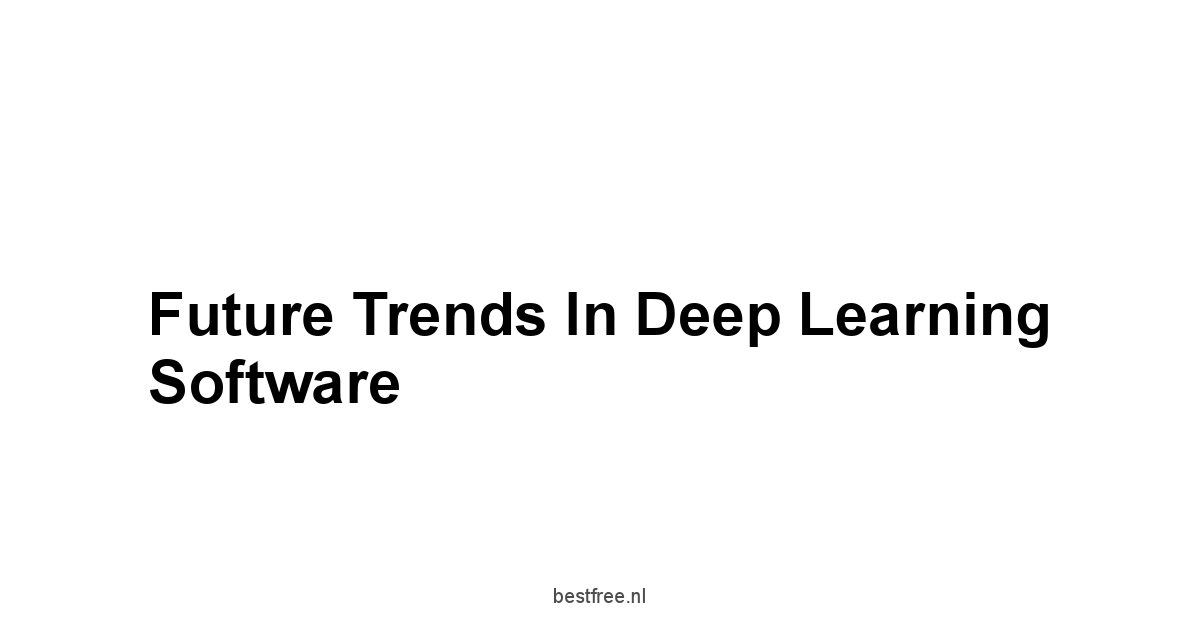
Enhanced Accessibility for Beginners
User-friendly tools are making deep learning accessible.
Efforts to clarify complex concepts empower more people to join the AI and machine learning conversation.
Anticipated Developments:
- Intuitive Interfaces: Usability upgrades for novice developers will keep coming.
- Educational Resources: Community-driven platforms will offer better tutorials, making deep learning easier.
As access grows, a wider range of contributors will push deep learning forward.
Growing Importance of Pre-trained Models
Pre-trained models save time and resources in deploying deep learning solutions.
These models, trained on vast datasets, can be adjusted for specific needs, enabling swift implementation.
Future Directions:
- Model Sharing Platforms: More repositories for pre-trained models will speed up development.
- Customization Options: Users will tailor pre-trained models to meet their specific needs.
The rising use of pre-trained models marks a change in how deep learning solutions are created and used.
Integration with Cloud Services
The shift to cloud platforms is a key trend in deep learning software deployment.
Cloud services offer scalable resources, letting users access powerful computing without heavy investment in infrastructure.
Trends to Watch:
- Hybrid Cloud Solutions: Flexibility will benefit organizations needing both on-site and cloud capabilities.
- SaaS Offerings for Deep Learning: Software as a Service models will make deep learning tools easy to access without high upfront costs.
The ongoing blending of deep learning with cloud infrastructure will change how organizations deploy and use these tools.
Development of Hybrid Models
The future of deep learning may include hybrid models, merging traditional algorithms with deep learning frameworks.
This flexibility lets systems take advantage of both strengths.
Potential Benefits:
- Improved Performance: Hybrid models enhance accuracy by mixing deep learning’s feature extraction with the clarity of traditional methods.
- Tailored Solutions: Organizations can craft custom models that fit unique challenges, boosting predictive power.
As deep learning advances, the shift toward hybrid models offers promising opportunities for better data use and decision-making.
Also read: best free mlops platforms in 2025
Building a Deep Learning Model
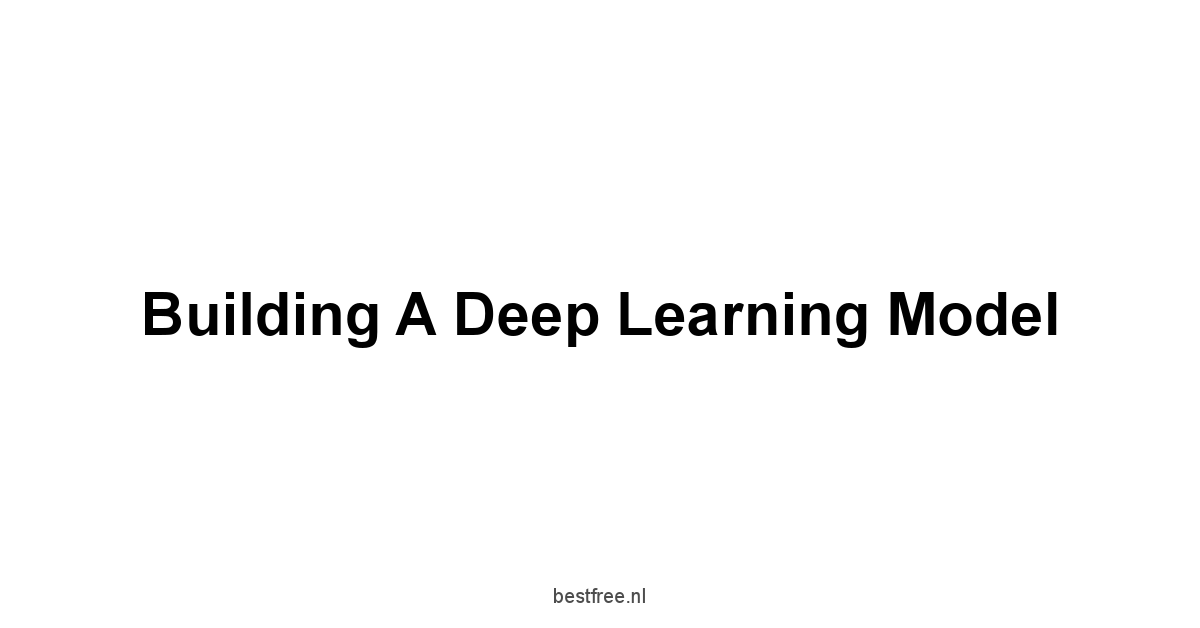
Constructing a deep learning model takes many steps.
Each phase is vital for effective training and meeting performance goals.
Data Preparation: The First Step
Data preparation is essential for any deep learning model.
Quality data lets the model find patterns accurately.
Key Steps in Data Preparation:
- Data Collection: Gather large amounts of data from reliable sources.
- Data Cleaning: Eliminate inconsistencies, duplicates, and missing values.
Data scientists use tools like Pandas and NumPy for data manipulation.
Gartner notes organizations with strong data preparation are three times more likely to succeed in deep learning.
Selecting the Right Framework
Choosing the right deep learning framework is critical.
Each framework has strengths and weaknesses that should align with project needs.
Factors for Consideration:
- Compatibility: Ensure the framework fits with existing systems.
- Community Support: Choose frameworks with active communities for problem-solving.
The choice between TensorFlow or PyTorch affects development speed and the learning curve for newcomers, shaping success.
Training and Tuning the Model
Training means running the model on the prepared dataset and adjusting parameters for better performance.
Steps Involved:
- Define Loss Function: Set the performance metric, such as Binary Crossentropy or Mean Squared Error.
- Select Optimizer: Pick algorithms like Adam or SGD to minimize the loss.
Hyperparameter tuning is vital for improving accuracy, optimizing learning rate, batch size, and epochs.
Evaluating Model Performance
Evaluating a model ensures it performs well on new data.
Using validation datasets, practitioners measure various metrics to understand learning.
Key Metrics:
- Accuracy: Assesses overall prediction correctness.
- Precision and Recall: Offer insight into specific classes and performance with imbalanced data.
Through rigorous evaluation, developers can deploy models that operate reliably in the real world.
Also read: 5 best free browsers
Where to Find Resources and Tutorials

Deep learning grows. Resources and tutorials matter for learning and skill.
Online Courses and Platforms
Many online platforms offer courses that teach deep learning well.
Some popular ones are:
- Coursera: Offers courses from top universities and institutions, often led by experts in AI.
- Udacity: Known for its Nanodegree programs that blend theory with hands-on projects.
Platforms like edX and DataCamp also provide specialized courses on deep learning frameworks and applications.
Community Forums and Discussion Groups
Engagement in community fosters learning.
Online forums are essential for connection and collaboration.
Where to Connect:
- Stack Overflow: A large resource for specific coding issues.
- Reddit: Subreddits like r/MachineLearning and r/learnmachinelearning encourage discussions on developments, resources, and support.
These communities help learners network and gain insights from experienced practitioners.
Documentation and Official Websites
Most deep learning frameworks come with thorough documentation.
Good documentation is crucial.
Key Documentation to Reference:
- TensorFlow Documentation: Includes tutorials, guides, and API references for different applications.
- PyTorch Documentation: Provides a guide on installation, use cases, and performance tips.
Proper documentation is a roadmap for beginners and experts, ensuring clarity in using the framework’s features.
Also read: best free synthetic media software in 2025
Conclusion on the Importance of Choosing the Right Tools

The Impact of Software Choice on Outcomes
Choosing deep learning software affects machine learning project outcomes.
Selecting frameworks that match organizational goals is essential for success.
Continuous Learning in Deep Learning Technology
Regularly updating skills and staying current with technologies keeps organizations competitive in deep learning.
Through careful selection and ongoing engagement, organizations can harness deep learning for transformative change.
Also read: best image recognition software in 2025
Final Thoughts
Deep learning software alters how machines understand data.
As organizations face vast information, the right software becomes essential for insight.
Frameworks like TensorFlow and PyTorch are gateways to innovation.
Their effectiveness shapes project outcomes, emphasizing the need for careful selection based on use cases and business goals.
Deep learning’s reach into various industries shows its power to transform.
In healthcare, algorithms now detect cancer with over 90% accuracy, improving patient outcomes.
Predictive analytics in finance forecasts market trends, highlighting deep learning’s role in decision-making. The AI market could exceed $11 billion by 2026.
As deep learning advances daily, practitioners must stay updated on the latest frameworks and methods.
Online courses, forums, and thorough documentation are vital for all levels of expertise.
Lifelong learning builds skills and equips organizations with techniques for efficiency and innovation.
The journey through deep learning is tough but rewarding.
By selecting the right tools and utilizing resources, organizations can access the vast potential of artificial intelligence.
This commitment to core principles lays the foundation for sustainable growth, fosters a data-driven culture, and embraces technological advancement.
Deep learning’s potential to shape our world is limited only by our curiosity to explore.
Also read: best free pricing software
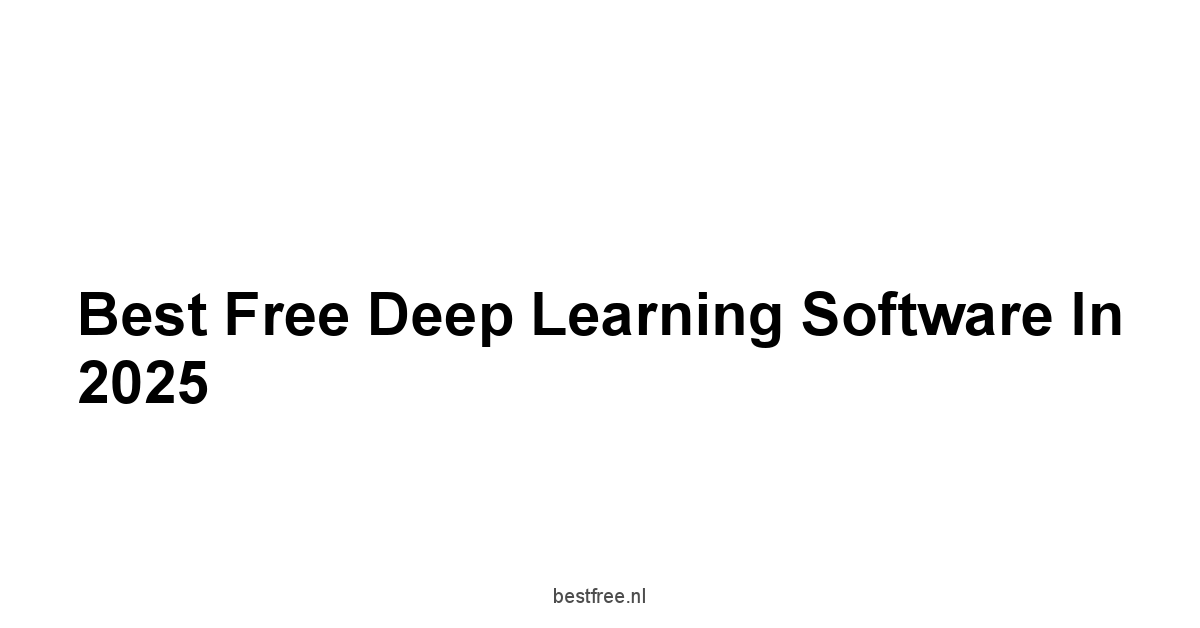




Leave a Reply